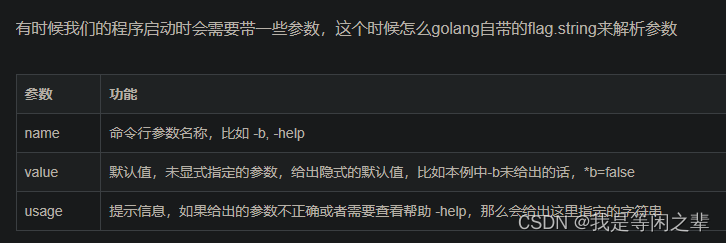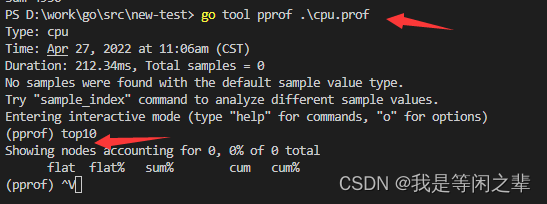pprof的用途
CPU Profiling:CPU 分析,按照一定的频率采集所监听的应用程序 CPU(含寄存器)的使用情况,可确定应用程序在主动消耗CPU 周
pprof的用途
- CPU Profiling:CPU 分析,按照一定的频率采集所监听的应用程序 CPU(含寄存器)的使用情况,可确定应用程序在主动消耗CPU 周期时花费时间的位置
- Memory Profiling:内存分析,在应用程序进行堆分配时记录堆栈跟踪,用于监视当前和历史内存使用情况,以及检查内存泄漏
- Block Profiling:阻塞分析,记录 goroutine 阻塞等待同步(包括定时器通道)的位置。阻塞分析对分析程序并发瓶颈非常有帮助。
- Mutex Profiling:互斥锁分析,报告互斥锁的竞争情况
所以当内存或者cpu飙升的时候,我们可以使用go自带的性能分析利器pprof来查找问题所在。
Go 语言自带的 pprof 库就可以分析程序的运行情况,并且提供可视化的功能。它包含两个相关的库:
runtime/pprof
对于只跑一次的程序,例如每天只跑一次的离线预处理程序,调用 pprof 包提供的函数,手动开启性能数据采集。
net/http/pprof
对于在线服务,对于一个 HTTP Server,访问 pprof 提供的 HTTP 接口,获得性能数据。当然,实际上这里底层也是调用的 runtime/pprof 提供的函数,封装成接口对外提供网络访问。
利用runtime/pprof包实现cpu分析的步骤
package main
import (
"flag"
"fmt"
"log"
"os"
"runtime/pprof"
)
//执行 go run main -help 查看帮助信息
//执行 go run main -cpuprofile cpu.prof 生成cpu性能分析文件
func main() {
var cpuprofile = flag.String("cpuprofile", "", "请输入 -cpuprofile 指定cpu性能分析文件名称")
//在所有flag都注册之后,调用:flag.Parse()
flag.Parse()
f, err := os.Create(*cpuprofile)
if err != nil {
log.Fatal("could not create CPU profile: ", err)
}
// StartCPUProfile为当前进程开启CPU profile。
if err := pprof.StartCPUProfile(f); err != nil {
log.Fatal("could not start CPU profile: ", err)
}
// StopCPUProfile会停止当前的CPU profile(如果有)
defer pprof.StopCPUProfile()
sum := 0
for i := 0; i < 100; i++ {
sum += i
}
fmt.Printf("sum=%d\n", sum)
}这里对flag.String参数的解释如下:


2、执行命令生成本地文件cpu.prof:
go run main.go -cpuprofile cpu.prof

3、对文件进行分析:
go tool pprof cpu.prof

对应的参数说明:

利用runtime/pprof包实现内存分析的步骤:
package main
import (
"flag"
"fmt"
"log"
"os"
"runtime"
"runtime/pprof"
)
//执行 go run main -help 查看帮助信息
//执行 go run main -menprofile men.prof 生成内存性能分析文件
func main() {
var menprofile = flag.String("menprofile", "", "请输入 -menprofile 指定内存性能分析文件名称")
//在所有flag都注册之后,调用:flag.Parse()
flag.Parse()
f, err := os.Create(*menprofile)
if err != nil {
log.Fatal("could not create memory profile: ", err)
}
defer f.Close() // error handling omitted for example
runtime.GC() // get up-to-date statistics
if err := pprof.WriteHeapProfile(f); err != nil {
log.Fatal("could not write memory profile: ", err)
}
sum := 0
for i := 0; i < 100; i++ {
sum += i
}
fmt.Printf("sum=%d\n", sum)
}然后就是生成本地性能分析文件和查看文件:

总结:
其实,我们可以把上面两个代码合并,输入 go run main.go -cpuprofile cpu.prof -menprofile men.prof同时生成cpu和内存的性能分析文件。
利用net/http/pprof包进行性能分析
这个很简单,直接启动一个端口(和正常提供业务服务的端口不同)监听 pprof 请求:
package main
import (
"fmt"
"gin_pro/pkg/setting"
"gin_pro/routers"
"net/http"
_ "net/http/pprof"
)
func main() {
//用于pprof检测内存使用情况
go func() {
http.ListenAndServe("0.0.0.0:8080", nil)
}()
router := routers.InitRouter()
s := &http.Server{
Addr: fmt.Sprintf(":%d", setting.HTTPPort),
Handler: router,
ReadTimeout: setting.ReadTimeout,
WriteTimeout: setting.WriteTimeout,
MaxHeaderBytes: 1 << 20, // 1* 2^20 = 1*1024*1024 = 1M
}
s.ListenAndServe()
}
然后在终端执行以下命令就能查看对应的数据了:
#所有过去内存分配的采样 go tool pprof http://127.0.0.1:8080/debug/pprof/allocs #对活动对象的内存分配进行采样(活动) go tool pprof http://127.0.0.1:8080/debug/pprof/heap # 下载 cpu profile,默认从当前开始收集 30s 的 cpu 使用情况,需要等待 30s go tool pprof http://127.0.0.1:8080/debug/pprof/profile # wait 120s go tool pprof http://127.0.0.1:8080/debug/pprof/profile?seconds=120 #导致同步原语阻塞的堆栈跟踪 go tool pprof http://127.0.0.1:8080/debug/pprof/block #所有当前goroutine的堆栈跟踪 go tool pprof http://127.0.0.1:8080/debug/pprof/goroutine #争用互斥锁持有者的堆栈跟踪 go tool pprof http://127.0.0.1:8080/debug/pprof/mutex #当前程序的执行轨迹。 go tool pprof http://127.0.0.1:8080/debug/pprof/trace
在可以直接在浏览器查看:
http://127.0.0.1:8080/debug/pprof/

总结
到此这篇关于go性能分析工具pprof的用途及使用的文章就介绍到这了,更多相关go性能分析工具pprof内容请搜索好代码网以前的文章或继续浏览下面的相关文章希望大家以后多多支持好代码网!
